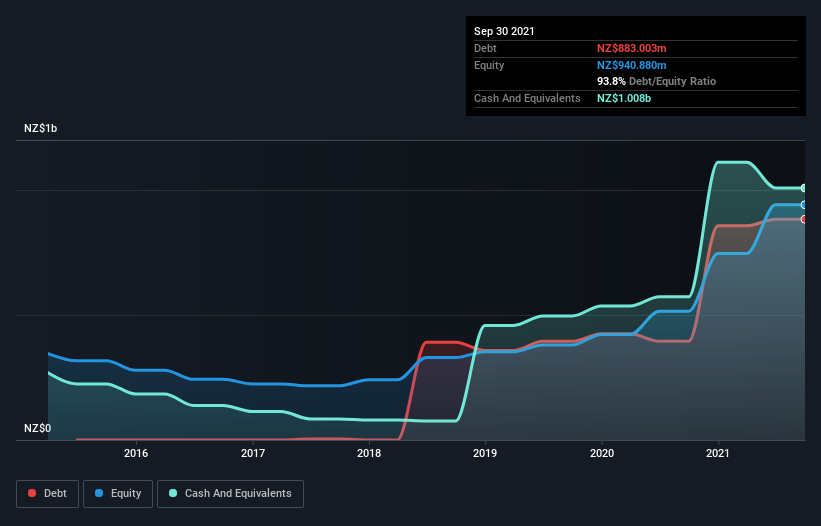These 4 Measures Indicate That Xero (ASX:XRO) Is Using Debt Reasonably Well

Howard Marks put it nicely when he said that, rather than worrying about share price volatility, 'The possibility of permanent loss is the risk I worry about... and every practical investor I know worries about.' So it seems the smart money knows that debt - which is usually involved in bankruptcies - is a very important factor, when you assess how risky a company is. We can see that Xero Limited (ASX:XRO) does use debt in its business. But should shareholders be worried about its use of debt?
What Risk Does Debt Bring?
Debt and other liabilities become risky for a business when it cannot easily fulfill those obligations, either with free cash flow or by raising capital at an attractive price. If things get really bad, the lenders can take control of the business. While that is not too common, we often do see indebted companies permanently diluting shareholders because lenders force them to raise capital at a distressed price. Of course, plenty of companies use debt to fund growth, without any negative consequences. The first step when considering a company's debt levels is to consider its cash and debt together.
Check out our latest analysis for Xero
What Is Xero's Net Debt?
The image below, which you can click on for greater detail, shows that at September 2021 Xero had debt of NZ$883.0m, up from NZ$394.9m in one year. However, it does have NZ$1.01b in cash offsetting this, leading to net cash of NZ$125.0m.

A Look At Xero's Liabilities
We can see from the most recent balance sheet that Xero had liabilities of NZ$164.0m falling due within a year, and liabilities of NZ$1.19b due beyond that. Offsetting these obligations, it had cash of NZ$1.01b as well as receivables valued at NZ$82.6m due within 12 months. So its liabilities total NZ$259.5m more than the combination of its cash and short-term receivables.
This state of affairs indicates that Xero's balance sheet looks quite solid, as its total liabilities are just about equal to its liquid assets. So while it's hard to imagine that the NZ$22.3b company is struggling for cash, we still think it's worth monitoring its balance sheet. Despite its noteworthy liabilities, Xero boasts net cash, so it's fair to say it does not have a heavy debt load!
Shareholders should be aware that Xero's EBIT was down 72% last year. If that earnings trend continues then paying off its debt will be about as easy as herding cats on to a roller coaster. When analysing debt levels, the balance sheet is the obvious place to start. But it is future earnings, more than anything, that will determine Xero's ability to maintain a healthy balance sheet going forward. So if you want to see what the professionals think, you might find this free report on analyst profit forecasts to be interesting.
Finally, while the tax-man may adore accounting profits, lenders only accept cold hard cash. While Xero has net cash on its balance sheet, it's still worth taking a look at its ability to convert earnings before interest and tax (EBIT) to free cash flow, to help us understand how quickly it is building (or eroding) that cash balance. Over the last three years, Xero recorded free cash flow worth a fulsome 83% of its EBIT, which is stronger than we'd usually expect. That puts it in a very strong position to pay down debt.
Summing up
We could understand if investors are concerned about Xero's liabilities, but we can be reassured by the fact it has has net cash of NZ$125.0m. The cherry on top was that in converted 83% of that EBIT to free cash flow, bringing in NZ$11m. So we don't have any problem with Xero's use of debt. We'd be motivated to research the stock further if we found out that Xero insiders have bought shares recently. If you would too, then you're in luck, since today we're sharing our list of reported insider transactions for free.
At the end of the day, it's often better to focus on companies that are free from net debt. You can access our special list of such companies (all with a track record of profit growth). It's free.
New: AI Stock Screener & Alerts
Our new AI Stock Screener scans the market every day to uncover opportunities.
• Dividend Powerhouses (3%+ Yield)
• Undervalued Small Caps with Insider Buying
• High growth Tech and AI Companies
Or build your own from over 50 metrics.
Have feedback on this article? Concerned about the content? Get in touch with us directly. Alternatively, email editorial-team (at) simplywallst.com.
This article by Simply Wall St is general in nature. We provide commentary based on historical data and analyst forecasts only using an unbiased methodology and our articles are not intended to be financial advice. It does not constitute a recommendation to buy or sell any stock, and does not take account of your objectives, or your financial situation. We aim to bring you long-term focused analysis driven by fundamental data. Note that our analysis may not factor in the latest price-sensitive company announcements or qualitative material. Simply Wall St has no position in any stocks mentioned.
About ASX:XRO
Xero
A software as a service company, provides online business solutions for small businesses and their advisors in Australia, New Zealand, and internationally.
Flawless balance sheet with reasonable growth potential.


